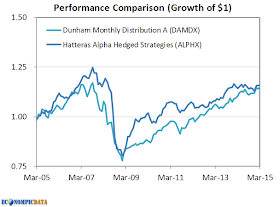High yield bonds: Where's the high yield?
As the right-hand chart below highlights, the 5.95% yield to worst of the Barclays U.S. High Yield Index (as of 4/30/15) is near its all-time low. Due to defaults, this yield should be thought of as the best case return that can be expected over a 5-10 year period, rather than the likely forward return.
Why? Over ten year periods since 1986 (the furthest back I could gather yield to worst data):
- The forward ten-year return of the Barclays U.S. High Yield Index has under-performed its yield 93% of the time
- The forward ten-year return of the Barclays U.S. High Yield Index has under-performed its yield by an average of 3.5% / year (with a 3.5% standard deviation)
While there are certainly no guarantees, given the 5.95% yield, history "implies" a ten year forward annualized return of 2.5% with a one-standard deviation range of -1% to 6%.
High yield vs. stocks: The story gets worse
While U.S. stocks appear expensive by most measures, they have nothing on high yield. Using the same format as above, the below compares the excess yield of high yield relative to stocks vs. the excess return of high yield relative to stocks.
The first thing you may notice in the right-hand chart below is that high yield's excess yield vs. stocks is only slightly above 2%, well shy of the 7% average from 1987 through 2005 and not even in the same ball park as the 15% level reached during the early 1990's and financial crisis. Note... the below uses the CAPE yield (more details here); using the S&P 500's current earnings yield gets you to a sub 1% figure, slightly above the negative level that occurred in 2013.
Relative performance results look even worse than high yield in isolation:
- High yield's forward ten-year relative performance vs. stocks has under-performed its excess yield 100% of the time
- High yield's forward ten-year relative performance vs. stocks has under-performed its excess yield by an average of 8.3% / year, with a 5.2% standard deviation
Given the current 2.2% excess yield of high yield bonds vs. stocks (as of 4/30/15), history "implies" a -6% ten-year annualized underperformance vs. stocks with a one-standard deviation range of annualized underperformance of -11% to -1%.
"History doesn't repeat itself, but it does rhyme" - Mark Twain
Looking back at the performance of high yield corporate bonds since the crisis, we see remarkably strong performance among the lowest credit quality segments of the market. It wasn't long ago that we found ourselves in a similar situation of lower quality outperformance; the chart below highlights the almost five year run from late 2002 through mid-2007 that looks awfully similar to the returns we've experienced since the end of 2008. In between these two time frames was a massive flight to quality / junk sell-off that took place during the financial crisis, which created the opportunity for the most recent period of junk outperformance (and NOBODY wanted to allocate to high yield in early 2009).
There are times when high yield bonds present an attractive opportunity in absolute or relative terms. Today does not appear to be one of them.











